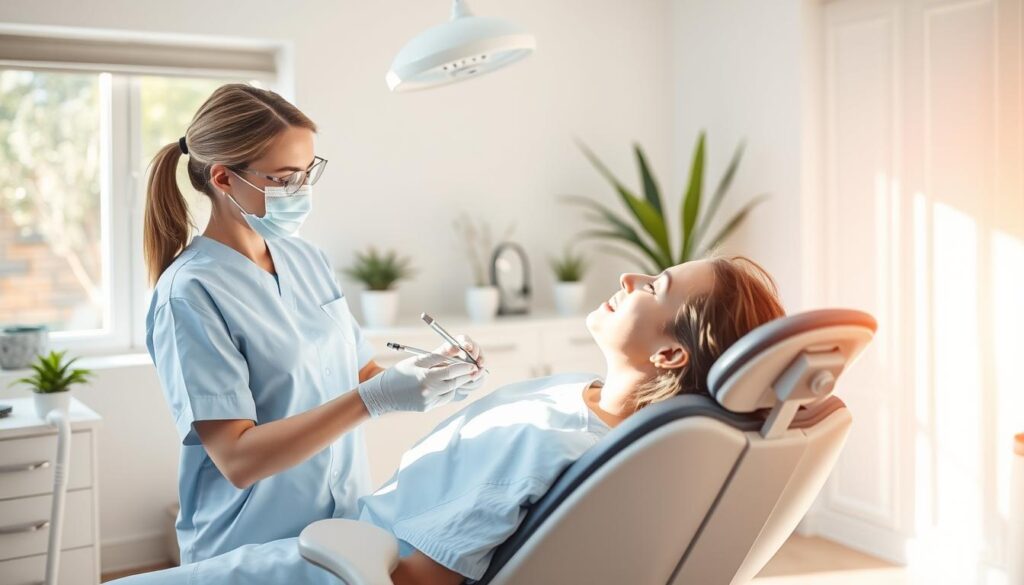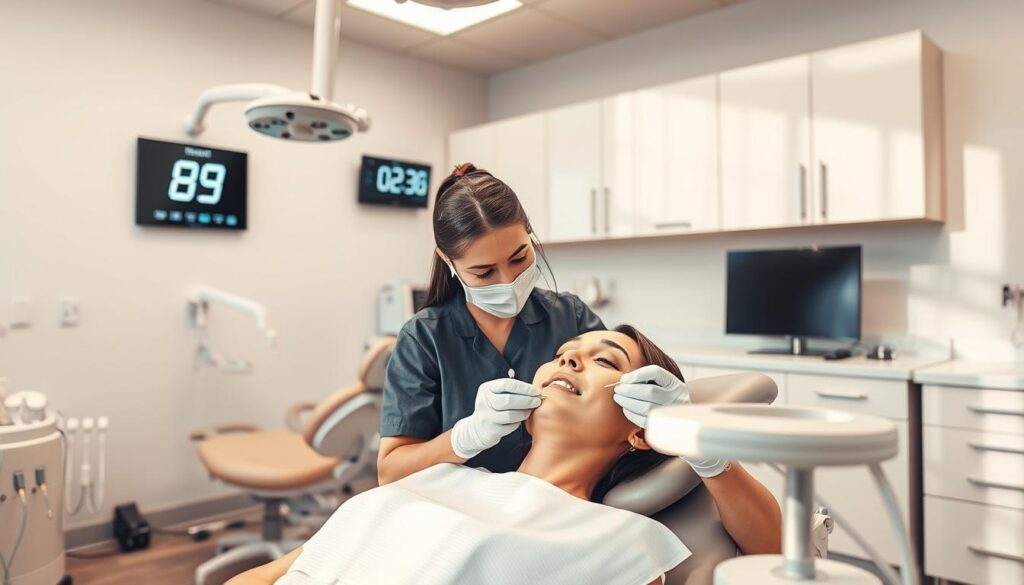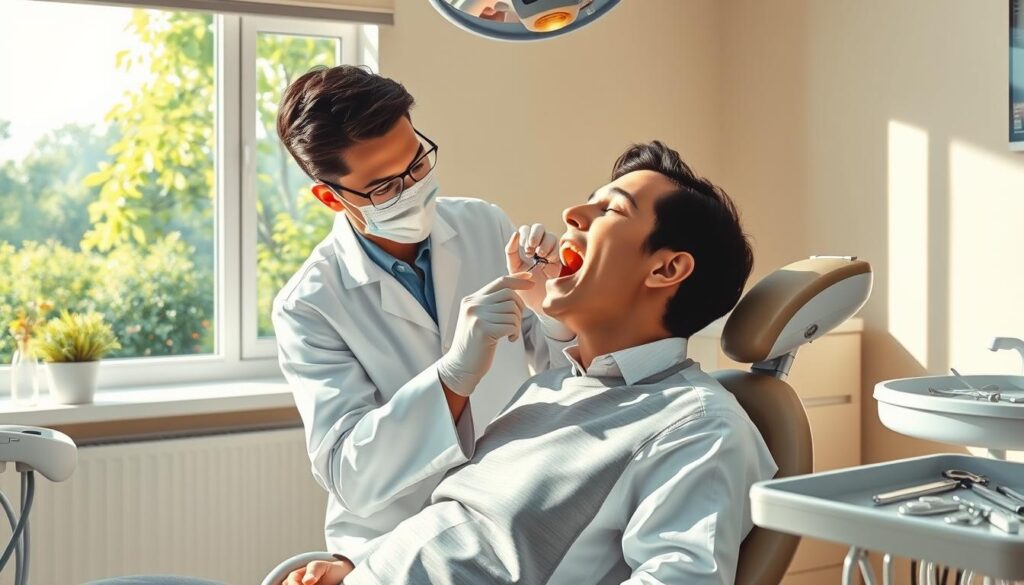How Long Does a Dental Exam and Cleaning Take?

Did you know that one in three people underestimate dental appointment times? So, how long does a dental exam and cleaning really take? It usually ranges from 30 minutes to an hour. This depends on your oral health and the treatments needed.
Spotting problems early can cut down on treatment time and keep you healthy longer. Our team works together to make each visit quick and reassuring. For more details, check out this dental exam and cleaning guide for tips on efficient care.
Key Takeaways
- Most standard visits last from 30 to 60 minutes overall.
- Regular screenings address small issues before they escalate.
- Preventive care helps reduce lengthy procedures later.
- A systematic approach fosters comfort and clear communication.
- Early interventions maintain ongoing oral health.
Overview of Dental Exams and Cleanings
Good oral health starts with regular check-ups. These visits catch early signs of cavities and gum problems. Using special tools helps spot risks early. This leads to better treatment and keeps you healthy for longer.

What Is a Dental Exam?
An exam starts with a look at your teeth, gums, and soft tissues. Doctors use X-rays, bite tests, and medical history to check for risks. This helps find problems early, before they get worse.
What Does a Dental Cleaning Involve?
Cleanings remove plaque and tartar with special tools. Polishing gets rid of stains, and flossing reaches hard spots. It’s all about stopping bacteria to keep your mouth healthy and prevent long cleanings.
Importance of Regular Dental Visits
Regular visits keep your gums healthy, your breath fresh, and teeth strong. Studies show that prevention saves money. Staying on top of dental care means better results and less time in the dentist’s chair. Good home care is key to keeping your mouth in top shape.
Typical Duration of a Dental Exam
Many patients wonder how this part of their visit compares to the average time for dental cleaning. A standard exam may seem brief, yet every minute is purposeful. Clinicians carefully gather information on past procedures, current medications, and any concerns that could signal early-stage issues.

Professionals often combine visual inspection with precise diagnostic methods. This thorough approach serves to identify subtle changes in oral health before they become more serious.
Initial Examination Process
Practitioners typically start by reviewing the patient’s medical history. They scan the gums, teeth, and bite alignment, checking for warning signs such as redness or irregularities. This step sets a solid foundation for determining any immediate needs or preventive measures.
Time for Diagnostic Tests
Imaging is an effective way to detect problems beneath the surface. Bitewing X-rays or panoramic scans might be used if risk factors emerge. These tests usually take five to fifteen minutes, depending on the complexity of the case.
Factors Affecting Duration
Some individuals require extra attention due to chronic inflammation or advanced conditions. Scheduling constraints in busy practices may stretch exam times as well. Despite variations, dental teams remain focused on comprehensive evaluation that supports long-term oral health.
| Common Exam Steps | Approx. Time (minutes) |
|---|---|
| Patient History Review | 5–10 |
| Visual Inspection | 5–10 |
| X-Rays / Scans | 5–15 |
| Treatment Discussion | 5–10 |
Duration of a Dental Cleaning
A thorough cleaning removes plaque and polishes teeth with precision. It often aligns with the overall dental check-up duration. This ensures a preventive approach that targets early signs of gingival concerns.
Professionals start by inspecting each surface to find buildup. This step shows trouble spots before the main cleaning begins. Keeping the patient comfortable is a top priority.
Standard Cleaning Process
Care includes gentle scaling around the gum line, followed by polishing with a specialized paste. Stubborn fragments are addressed, and flossing completes the routine. Teeth often feel smoother and look brighter afterward.
Use of Technology in Cleanings
Ultrasonic scalers reduce manual strain and preserve enamel. Digital radiographs pinpoint hidden tartar, speeding up each step. This approach boosts efficiency and keeps patient discomfort minimal.
Comparison of Regular vs. Deep Cleaning
A regular cleaning focuses on mild deposits. A deep cleaning targets any deeper pockets beneath the gum line, often spanning a longer dental check-up duration. Periodontal cases may require extra sessions but protect long-term oral health.
| Cleaning Type | Approximate Time |
|---|---|
| Routine Maintenance | 20–40 minutes |
| Deep Cleaning | 45–60 minutes |
Factors Influencing Appointment Length
Many things affect how long a dental visit lasts. Some patients have a lot of plaque, while others have less. What makes some visits longer and others shorter?
Patient’s Oral Health Status
People with gum disease or many cavities need more time. Treatments for these issues involve removing plaque and checking tissue health. Keeping teeth clean at home can help avoid these problems.
Complexity of Procedures
Fillings, root planing, and restorations take longer. These tasks need special tools and focus. So, they make visits longer.
Dentist’s Practice Efficiency
A well-run office uses efficient scheduling and modern tools. Teams skilled in new techniques work faster. This makes visits shorter and safer.
| Influencing Factor | Potential Impact on Timing |
|---|---|
| Extent of Oral Disease | Longer cleaning and checkups |
| Procedure Specifics | Multiple services may extend appointment |
| Clinic Efficiency | Optimized workflows reduce overall duration |
Preparation for Your Dental Visit
Getting ready for a dental checkup can make you feel less stressed. It can also make your visit shorter. Patients who plan ahead often have more time at the dentist. Feeling calm and ready can help you talk better with the dental team.
What to Do Before Your Appointment
Setting clear goals can make your visit smoother. Think about any changes in your mouth and write down questions. Drinking water and getting enough sleep can also help you feel more comfortable.
Check out this broken tooth repair resource if you have an urgent issue.
Necessary Documentation to Bring
Forms and insurance details are crucial. Having them ready can save a lot of time. Keep your health records in a place you can easily find them.
Dress Code and Personal Items
Wear loose clothes to be more comfortable. Don’t forget glasses or hearing aids. Being organized helps you focus on what’s important during the exam.
| Preparation Step | Benefit |
|---|---|
| Complete forms beforehand | Speeds up registration |
| Comfortable attire | Improves overall relaxation |
| Bring all essential records | Ensures a swift check-in |
What to Expect During the Appointment
Patients often wonder about the steps before, during, and after a thorough exam. The front desk usually gives out any needed forms. They also explain the expected schedule.

Initial Steps Upon Arrival
A brief greeting helps patients feel at ease. Staff members confirm patient details and guide them to the right area for initial assessments. X-rays or oral cancer screenings may be done to find any hidden issues.
Hygienists often explain each tool and its purpose.
During the Exam and Cleaning
The dentist reviews all findings, documenting tooth condition, gum health, and potential problem areas. A collaborative approach between dentist and hygienist keeps everything efficient. Each patient gets customized advice on brushing or flossing techniques.
This advice supports consistent dental care time throughout the year.
Aftercare Recommendations
Clear instructions guide patients on managing minor sensitivity, maintaining oral hygiene routines, and scheduling follow-up visits. Suggestions may include specific rinses, next appointment reminders, and advice for sustaining the best results. Following these tips optimizes dental care time between visits.
Tips for a Faster Appointment
Is there a way to make dental visits quicker without sacrificing care? Our schedules can get busy fast. But, a few strategies can make your dental check-ups faster and still thorough.
How to Maximize Efficiency
Staying on top of routine exams can prevent surprises. Keeping your medical records up to date and sharing any new health issues early helps your dentist prepare better.
- Avoid peak times when scheduling
- Consolidate multiple treatments if possible
- Complete paperwork online before arrival
Communicating with Your Dentist
Telling your dentist about any tooth sensitivity or new symptoms helps them plan better. This way, they can give you the right amount of time for each treatment, avoiding delays.
Scheduling Considerations
Many clinics offer flexible scheduling for both simple and complex treatments. Booking an early morning slot can mean less waiting time. This approach reduces stress and keeps your dental visit shorter than expected.
Frequency of Dental Exams and Cleanings
Regular dental checkups help find cavities or gum problems early. The American Dental Association recommends going twice a year. This helps keep your teeth and gums healthy and comfortable.
Recommended Visit Schedule
How often you should go depends on your health. Here’s a possible plan:
- Most adults should go every six months.
- People with gum disease might need to go every three months.
- Those with chronic conditions might need to adjust their schedule.
Age and Health Considerations
Children need more visits as their teeth grow. Older adults with dental work or osteoporosis might also need more visits. This helps with growth and protects weak areas.
Special Circumstances for Increased Visits
People with orthodontic work, weak immunity, or recent surgeries need more visits. Certain health issues might require more frequent checkups. This helps catch problems early.
Conclusion: Why Timing Matters in Dental Care
Routine exams and cleanings are key to a healthy life. They find small problems early and help prevent bigger ones. This way, you avoid more serious treatments.
Importance of Regular Check-Ups
Preventive check-ups catch gum or tooth issues early. This helps keep your teeth and mouth healthy. The American Dental Association says these visits are crucial for a healthy smile.
Long-Term Benefits of Timely Dental Care
Regular cleanings prevent expensive treatments later. They also reduce pain and help keep your smile strong. This leads to confidence that lasts a lifetime.
Encouraging Regular Appointments
Seeing your dentist often builds trust. It leads to open talks about your dental health. This is why regular visits are essential for good oral health everywhere.


